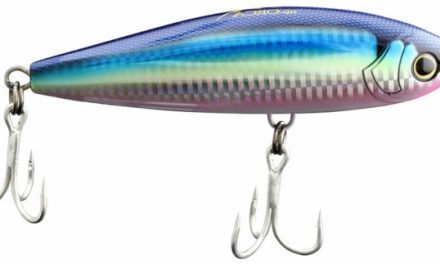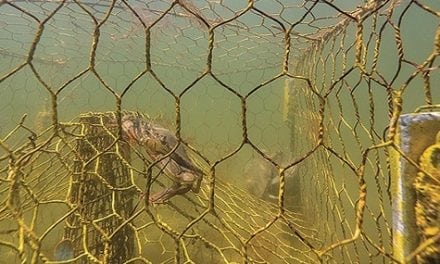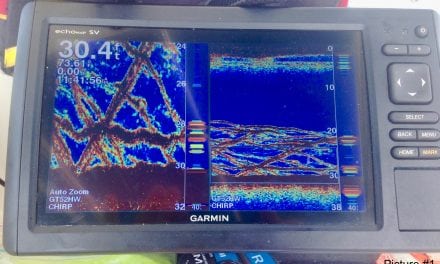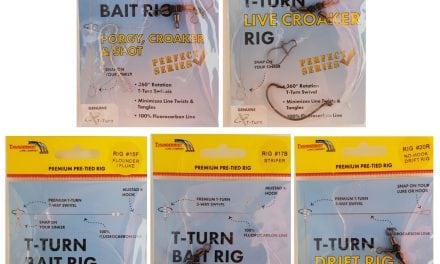The speed of a sprinter, the grace of a ballerina and amazing aerial pageantry befitting a Cirque du Soleil performance — that’s Istiophorus platypterus. They go by “sailfish,” in Florida’s southeastern waters, where massive fall-winter migrations deliver banner day potential.
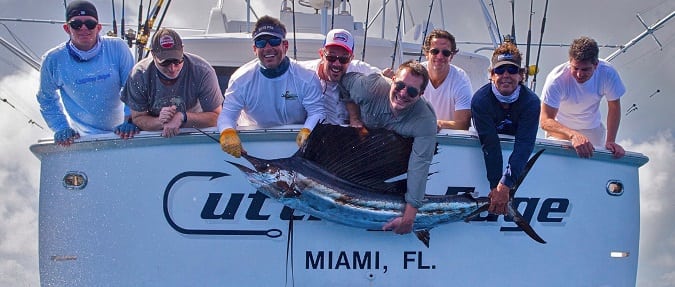
Ranging from the Gulf of Maine to Brazil, sails migrate northward during the spring-summer months and return southward along the warm Gulfstream when autumn’s cooling hints of winter’s approach. Unlike marlin and swordfish, which favor deep water, sails are commonly caught within eyesight of the coast.
Raymarine pro Capt. Quinton Dieterle, who runs the 45-foot Hatteras “Cutting Edge” out of Key Biscayne’s Crandon Park Marina, said fluctuating conditions typically chops the southern run into incremental pushes. Sails like that 75- to 80-degree water temperature with light current and moving bait schools, but the sea remains a dynamic canvas.
“The funny thing about sailfish is you can sit out there one day and not catch a single thing; but you can go the next day and catch 18, 19 fish,” Dierterle said. “It’s not that the fish disappear; they go into a lock-down mode.
“They only move when conditions are right for them to move. Otherwise, they burn up too much energy. Instinct tells them they have to get south by a certain time, so when the current is light, they’ll move. Otherwise, they’ll lock down and stay.”
 |
Based out of Hillsboro Inlet, Capt. Art Sapp runs the “Liquid”, a 39-foot Sea Vee with quad Mercury 350 Verados. For him, water clarity factors greatly in sailfish pursuits.
“We like to see good clean water — preferably blue water — a northbound current and a show of ballyhoo, bonitos or whatever bait they’re feeding on,” Sapp said. “I think the clean water gets them excited. Generally, if you’re catching fish in dirty water it’s a very lethargic bite; they’re not really in a feeding pattern, but it’s just an opportunity.
“But when they’re feeding in the clean water, it’s generally an aggressive bite. You see them coming from a long ways off, because they can see the bait that much better. And our visibility is better too and that allows me to hunt them better in that cleaner water.”
As Dieterle notes, the sails’ southern migration takes them to warm tropical spawning waters. So, while biology plots the course, daily sea conditions set the pace.
Traditionally, fall-winter cold fronts delight sailfish anglers, as winds opposing the Gulfstream’s northward flow offers sails strategic benefit. It’s called “tailing” — riding wave tops like they’re surfing.
“As a cold front comes through and that wind goes around to the north, the wind goes against the current and creates a big swell,” Dieterle said. “Any of the fish that were hanging deep to get out of the current realize that they can flip to the surface and get on top of the waves.
“They look like they’re swimming, but they’re really just treading water. On top of the swell there’s less current than there is down in the water column.”
For anglers, this creates a target-rich opportunity. Spot a group of sails tailing on the swells and you can pick off several with well-placed presentations.
WHERE TO FIND ‘EM
 |
For his day-to-day searching, Sapp relies primarily on his Raymarine gS Series unit, but he runs a compact eS Series HybridTouch in the tower. With either unit, Sapp said superior clarity and adjustability proves invaluable in locating sailfish.
“The reason I go with Raymarine 100 percent and always have is the maximum control over the bottom machine’s power output,” he said. “You can change the gain on any unit, but you can back that thing down and you won’t hear the transducer clicking or chirping if you actually get in the water and swim underneath the boat. With the majority of units, if you can’t back them down at all, they’re just thumping away.
“We’re fishing in less than 200 feet of water 90 percent of the time and I don’t want it banging hard as if we were in 1,000 feet of water trying to mark bottom. I want a very gentle, quiet ping and Raymarine gives that to you with very few button pushes so you don’t have to go back deep in the menus.”
For him, eyeballing fish is always preferred, but a good show of bait on his Raymarine units or at the surface also sparks hope.
“It’s frequently physically seeing fish, but it can also be a good push of bait — anything that says the sailfish might be there,” Sapp said. “I don’t believe they feed on flying fish very frequently, but the flyers certainly get out of their way when the sailfish are coming.
“So, if I see a push of bait, or little needlefish or ballyhoo skipping, I’ll try to get in line with that because it often turns into sailfish bites.”

Raymarine CP570
|
Dieterle uses a Raymarine eS125 for his chart plotter and the CP570 for his sonar. The latter proves particularly helpful in dialing in sailfish location. His experience marking marlin on fish attracting devices (FADs) in the Dominican Republic helped him learn to identify fish on his recorder — a skill he now leverages off the Florida coast.
“Now, when I’m looking for sailfish off the Juno Ledge — a drop from 100 to 130 feet of water — I’ll go up and down that edge and look for the bait,” Dieterle said. “Occasionally, we’ll see what looks like sailfish and when we set up there we’ll get bites.
“It’s crucial when you’re fishing with 30-50 boats in a tournament and you’re going up and down the edge with hundreds of thousands of dollars on the line; some guys are just plopping out baits anywhere, but we’re going up and down the line looking for these pods of bait that sailfish have balled up, or any sailfish that are in the area.”
Complementing his sonar views, Dieterle keeps himself in the right neighborhood with ultra high-resolution chartplotter views of the contour lines. Spotting the drops, the pinnacles and any other fish-friendly variances prevents burning time in dead water.
“If you’re not sure where they are, at least pinpoint a spot that looks good, instead of just blind fishing,” Dieterle said.
THE NEW STUFF

New Raymarine Axiom family.
|
Ever eager to advance his game, Dieterle said he has great expectations for Raymarine’s new Axiom touch-screen multifunction navigation units. For him, the quad-core performance will be game-changing.
“It’s a major breakthrough when you can have everything launching from one transducer, as far as all your sonar stuff, the new Lighthouse 3 operating system, the availability of Navionics, super-fast quad-core processor… it’s amazing technology,” Dieterle said.
“That’s huge because if I get a bite, I want to turn around, mark the spot and keep fishing. I don’t want to sit there and wait for the unit to take forever to acknowledge everything. With the Axiom unit, you hit it, you save it, you go. The speed of this unit is one thing that will be a major help.”
Complementing the tactical advantages, Dieterle also sees Axiom units also enhancing comfort and security.
“When you’re out there and it’s rough and rainy, you’re opening up the console to plug in numbers and when a unit takes forever to load, you’re sitting there soaking things,” he said. “Also it’s a safety thing. When you’re reaching into the box to set up your course, you’re not in stance; it’s kind of awkward. So, when it all goes quickly, that’s great.”
SPREAD OUT
Sailfish fall for a diversity of tactics from trolled plugs and rigged ballyhoo, to bait-and-switch fly fishing techniques. For most, it’s hard to beat a spread of kite baits.
Summarily, a sturdy kite rod deploys a kite clipped to braided line. Snapping a release clip around the fishing line, anglers feed out line from the kite reel and fishing reel simultaneously until the kite’s height suspends a live bait barely below the surface. The bait’s frantic effort to dive deeper creates a constant commotion that sails recognize as vulnerable prey. When a fish grabs a bait, the line pops free from the clip and you’re clear to fight the fish right off the fishing rod.
Experienced crews often run two kites, each with three lines spaced at set distances by stoppers on the kite line. Sapp likes hardy goggle eyes (bigeye scad) on his longest kite lines, with threadfin herring or scaled sardines on the middle and short lines. If the sails show preference for the big baits, he’ll switch them into all positions.
Sapp’s rigging tip: “If the fish are up tailing or free jumping, we’ll switch from bridling them in the back to bridling them through the nose so we can pull them through the water quickly and get in front of sighted fish. You’re less likely to pull them out of the clips when they’re bridled through the nose.”
Complementing his kite baits, Sapp keeps a live herring or sardine rigged on a heavy spinning outfit for casting off the stern. Sight casting or simply throwing to a likely scenario (i.e. bait pushes) often yields the bonus bite.

Photo courtesy of Capt. Quinton Dieterle
|
Dieterle also keeps a live bait on a flat line, but his is more of a steady deployment. He may add a rubber core sinker to probe the water column for deeper sails.
“On full moon, the fish feed will feed more at night and in the daytime, they may not be in their feeding mode up on the surface,” he said. “They’ll sink down, so we’ll keep a bait in the lower two thirds.
“We’ll have one guy that fishes that one line by letting it out or bringing it up. We’ll use a smaller bait; something that can be reeled in a cast quickly if we need to,” Dieterle said.
Tip: Dieterle uses a system of permanent marker dashes on his line to quickly identify the bait’s depth and identify where bites occur. Replicating successful presentations often yields additional bites.
A hooked sailfish will unleash an unforgettable fury of fanciful feats. Hold on tight, Sapp says, and let the fish run its tank dry.
“Don’t horse them, take your time and be gentle, he said. “If you’re using circle hooks, which you should be, they won’t come unhooked.
“Back way off, let them do their thing and when they settle down, reengage.”
Now, sailfishing can be a rapid-fire adrenaline rush with the liquid playing field rapidly shifting moment by moment. That’s why legendary South Florida sailfish captain, Ray Rosher lauds the Raymarine screen clarity – and essential element for timely decisions like those that led him and his Miss Britt / Contender Boats victory in the Bluewater Movements, Inc. 2017 Sailfish Challenge with a total of 16 releases.
“When I’m in the tuna tower in full sun, at a glance, I can determine the depth that I’m fishing or see marks of baitfish or target species on the screen,” he said. “I can gain that information quickly.
“Also, my Raymarine units have a pretty simple operation, so I’m able to (effortlessly) change screens or get the data I need.”
The post Step Up For Sailfish Tactics appeared first on ODU Magazine-North America's #1 Digital Fishing Magazine.













